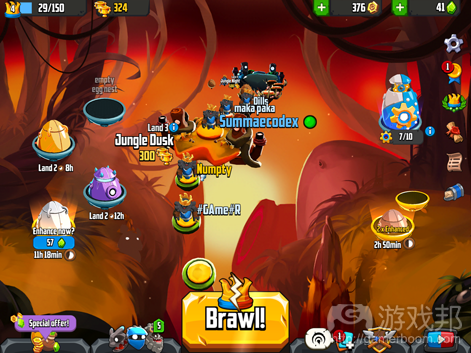多位开发者分享制作成功Instant Games的6个技巧
多位开发者分享制作成功Instant Games的6个技巧
原作者:Joy Marianowicz 译者:Willow Wu
来自育碧的Pierre-Hugues Puechlong、Lotum的Jens Abke以及来自Game Closure的Michael Carter和我们分享了他们是如何利用Facebook的社交发现优势建立活跃繁荣的游戏社区。如何才能让自己的小游戏(Instant Games)获得成功?我们总结出了以下6个技巧:
1.打造深度社交体验
育碧公司开发的小游戏意在创造深度的社交用户体验。Facebook自带的社交整合功能使得游戏社区成员在小游戏平台内外都可以交流。构建深度社交体验的游戏能够拥有更高的留存率、更容易产生病毒式传播,因此确保你的游戏具有社交特性是提升曝光率的关键第一步。谈到Lotum的经验,Jens告诉我们平台上表现最好的是那些回合制游戏,它们利用了Facebook的消息推送功能——4 Pics 1 Word经常被视为游戏智能助手(game bot)的最佳应用典范。Jens建议开发者认真思考游戏的用户接入点以及设计规划中的游戏特色,评估它是否是一个优秀的社交集成产品。
2.测试&迭代
Jens和Pierre-Hugues都认为持续进行A/B测试是打造成功小游戏的重点之一。发布更新操作简单,再加上Facebook庞大的用户规模,开发商加入游戏新特性并不需要费多少工夫,而且在短时间内就能获得用户的反馈。Lotum和Ubisoft都利用了Facebook Analytics来跟踪测试结果,从而了解该如何迭代、改进游戏。
3.再度吸引玩家&细分用户
在Game Closure,Michael认为玩家的留存挑战来源于两个方面:尽快再度吸引玩家和长期忠诚度的维持。再度吸引用户可以通过好友之间的自然社交互动来实现,可以通过设置choose.async API,让玩家提示彼此在游戏中采取行动。那些长期参与游戏的玩家也具有的留存挑战,因为他们的朋友陆陆续续会抛弃游戏,不太容易找到同样水准的竞争对手。锦标赛可以有效地聚集社区成员,让玩家找到实力相当的对手。
4.创建高质量的内容
眼前的玩家可以成为你最坚定的拥护者。制作有记忆点、可分享的游戏内容,这是实现病毒式传播的关键。Michael表示分享这个营销工具对Game Closure非常重要,他们在积极尝试什么样的游戏内容会促使玩家产生分享的欲望。团队创造令人兴奋的内容,鼓励玩家和他们的朋友采取高价值的行动,比如发表评论、再次分享或标记朋友。
5.利用Facebook的展示功能
游戏开发者可以利用Facebook上的内容展示区域触及平台上7亿多观看游戏视频、参与游戏社群互动的用户。Jens建议开发者要多利用游戏社群,育碧公司已经有了一个成功的社群论坛。游戏主页和社群是很有利用价值的,在那里可以和粉丝交流,获得反馈,听听他们对游戏更新有什么想法。
6.考虑多个盈利策略
Game Closure建议根据用户洞察调整你的盈利策略,并在同一平台上利用多种盈利策略来提高总收入。Facebook Gaming平台上超过半数的开发商都采用了混合盈利策略,将应用内广告(IAA)和应用内购买(IAP)结合使用。就广告形式而言,有奖视频(用户观看广告可以获得游戏内奖励)既是内购的一种补充手段,也可以在一定程度上刺激玩家消费,增加内购收入。
本文由游戏邦编译,转载请注明来源,或咨询微信zhengjintiao
We were joined by Pierre-Hugues Puechlong, Ubisoft; Jens Abke, Lotum; and Michael Carter, Game Closure to discuss how they’ve leveraged the power of Facebook’s social discovery to build thriving communities for their games. Here’s 6 x tips we heard for building successful Instant Games.
1. Build a Deeply Social Experience
Ubisoft were driven to build Instant Games to create a user experience that is deeply social. The native social integrations on Facebook enable gaming communities to engage with each other both on and off the Instant Games platform. Building games with deep social integration leads to higher retention and virality, so ensuring your game is social is a critical first step to helping drive discovery of your games. Speaking to Lotum’s experience, Jens tells us that the highest performing games they have on the platform are turn-based, which leverages the notifications feature on Facebook. The 4 Pics 1 Word puzzle game is often referenced as a best practice for game bot mechanics. Jens recommends that developers look closely at their game entry points for users and what features are in their road map, to evaluate if it has a good use case for social integrations. You can learn more about how to build social elements in solo games on our blog.
2. Test and Iterate
Jens and Pierre-Hugues attribute continuous A/B testing as a factor for building successful Instant Games. The ease of publishing updates to a sub-set of your audience, combined with the scale of Facebook’s audience, make it exceptionally easy to deploy new features and receive almost instantaneous feedback from users. Both Lotum and Ubisoft utilise Facebook Analytics to monitor the performance of these tests, which informs how they iterate and improve the game.
3. Re-Engage Early and Segment Your Community to Retain Hardcore Players
At Game Closure, Michael thinks of player retention challenges in two areas; early re-engagement and long-term loyalty. Early re-engagement can be achieved by enabling organic social interactions between friends, where they can prompt each other to take action in the game via the choose.async API. Players who have a long-term affinity with your title can be equally challenging to retain, as their friends begin to churn and they struggle to find equally skilled competitors. Tournaments are an effective tool for bringing communities together, enabling players to find competitors at their level.
4. Create Quality Content
Existing players can be your biggest advocates! Building meaningful moments into your game and marking those events with shareable content is key to achieving virality. Michael states the importance of this marketing tool for Game Closure, where the team actively explores what type of content from their games will resonate in a social share. They create exciting content that will motivate players and their networks to take a high value action such as comment on a post, re-share, or tag a friend. You can implement this capability to your game with the Custom Sharing SDK.
5. Leverage Facebook Surfaces
There are many content surfaces that game developers can leverage to reach the 700M+ people who play games, watch gaming videos or engage in gaming groups on our platform. Jens recommends leveraging gaming Groups, which has been a successful community forum for Ubisoft. Pages and Groups are a great place to talk with your fans, get feedback, and see what they’d like in updates to your games.
6. Consider Multiple Monetisation Strategies
Game Closure recommends adapting your monetisation strategy by platform based on user insights, and leveraging multiple monetisation strategies on the same platform to optimise for total revenue. We see this with Facebook Gaming developers – over half apply a hybrid monetisation strategy by using a combination of in-app adverts (IAA) and in-app purchases (IAP).* In terms of ad formats, Rewarded Video, where the user chooses to watch an advert for an in-game reward, drives incremental revenue in a way that is both complementary to and also a “gateway” for more in-app purchases.
(source: pocket gamer )








































 闽公网安备35020302001549号
闽公网安备35020302001549号